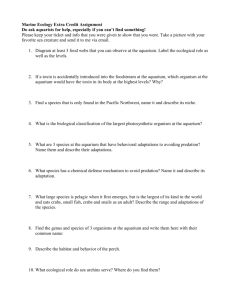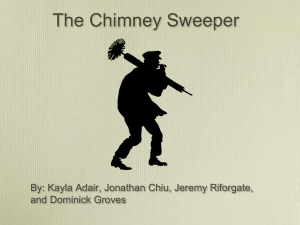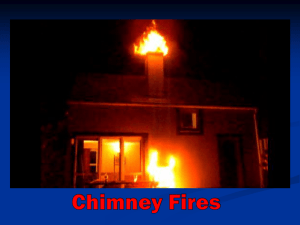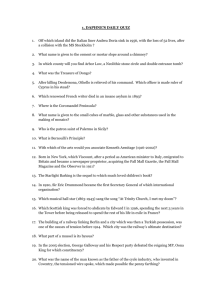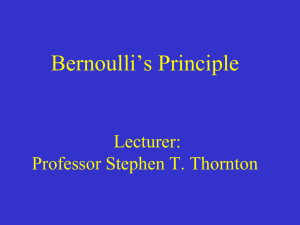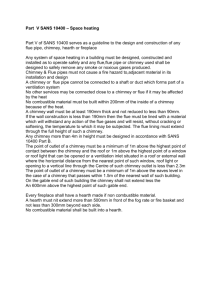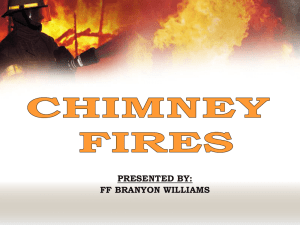Making Wind (not the kind your thinking)
advertisement
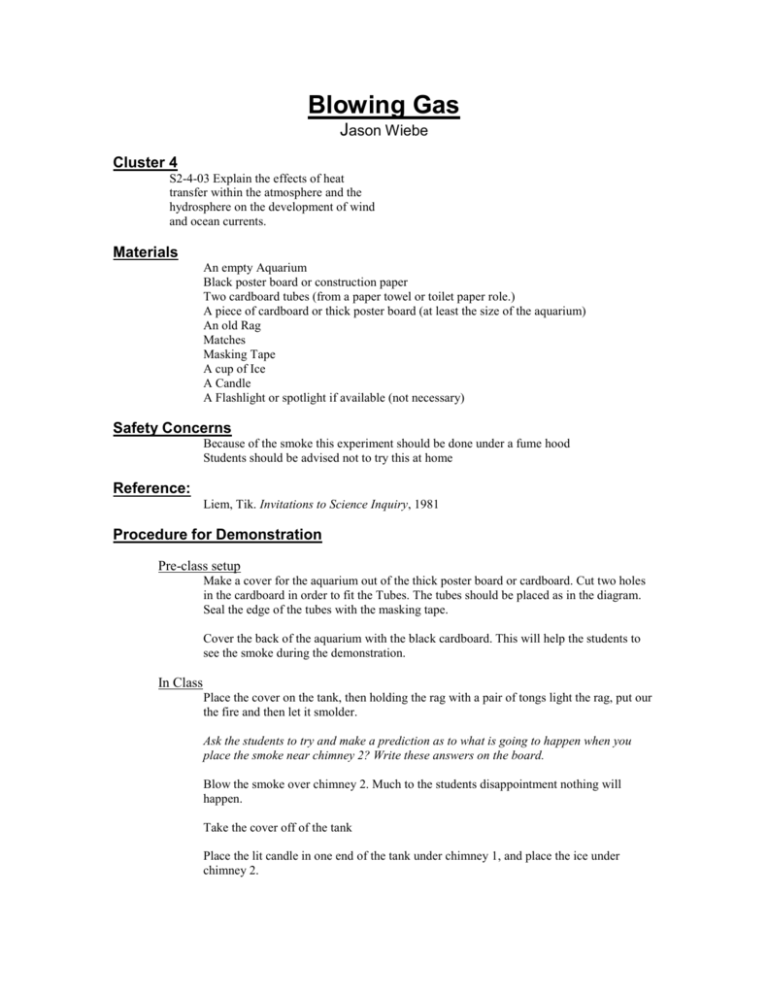
Blowing Gas Jason Wiebe Cluster 4 S2-4-03 Explain the effects of heat transfer within the atmosphere and the hydrosphere on the development of wind and ocean currents. Materials An empty Aquarium Black poster board or construction paper Two cardboard tubes (from a paper towel or toilet paper role.) A piece of cardboard or thick poster board (at least the size of the aquarium) An old Rag Matches Masking Tape A cup of Ice A Candle A Flashlight or spotlight if available (not necessary) Safety Concerns Because of the smoke this experiment should be done under a fume hood Students should be advised not to try this at home Reference: Liem, Tik. Invitations to Science Inquiry, 1981 Procedure for Demonstration Pre-class setup Make a cover for the aquarium out of the thick poster board or cardboard. Cut two holes in the cardboard in order to fit the Tubes. The tubes should be placed as in the diagram. Seal the edge of the tubes with the masking tape. Cover the back of the aquarium with the black cardboard. This will help the students to see the smoke during the demonstration. In Class Place the cover on the tank, then holding the rag with a pair of tongs light the rag, put our the fire and then let it smolder. Ask the students to try and make a prediction as to what is going to happen when you place the smoke near chimney 2? Write these answers on the board. Blow the smoke over chimney 2. Much to the students disappointment nothing will happen. Take the cover off of the tank Place the lit candle in one end of the tank under chimney 1, and place the ice under chimney 2. Put the cover on the aquarium and seal it shut with masking tape. The only way for air to get in and out of the aquarium now is through the two chimneys Again have the students predict what is happening in the aquarium. Since they cannot see any movement many will respond by saying that there is nothing unusual going on. Again, write the student answers down on the board. Hold the rag with a set of tongs. Light the rag and then let it smoulder. This creates the required smoke. Now hold the shouldering rag close to chimney 2 and blow the smoke over the chimney. The smoke will travel down chimney 2 towards the ice move across the tank towards the candle and finally exit the aquarium through chimney 1. Ask students what parts of the demonstration changed from the first demonstration to the second demonstration. Write their answers on the board. Draw a diagram of the aquarium on the board. Chalk in hand place it on the board just above chimney 2 and tell the students that they are going to help you draw the path of the smoke. Have the students start to direct the path of your chalk line. They will direct the line down the first chimney. When you get to the bottom… STOP. Ask the students if they know why. At this stage many students will understand that warm air rises and cold air sinks. However, If students do not know at first, guide them with a series of questions involving cold air falling. (E.g. On a hot day which area of the house is the coolest….the basement.) Guide them to the concept that cold air falls. Next place your chalk just above the diagram of the candle. Have the students direct the line. Once you are outside, stop the line again. Ask why the smoke rose. Most kids will be able to say because hot air rises. They will usually be confident in this answer. Now put your chalk on the bottom end of the first line that you drew. Ask the students to direct the smoke. They will direct it to the bottom of the line you drew from the candle. Now ask why. This should stump them. They already have the knowledge that cold air sinks, hot air rises. But they have no Idea why the air will travel sideways. This is where you must physiologically guide them to discover their answer through another series of questions and diagrams. Q) Is smoke the only thing that enters the aquarium through chimney 2? A) No, air also flows into the tank through chimney 2. Q) When the air enters through chimney 2, where does the air that was already under chimney two go? A) The air gets pushed over to the other side of the tank Q) What happens when the air gets to the other side of the tank? A) It gets heated and rises out of the tank Q) Essentially, what is this movement of air inside the tank called? A) WIND!!!! We learned from the wind chimney demonstration that the uneven heating of air creates wind in an aquarium. Reflection on Demonstration What was the purpose of this investigation? What were the two main variables in this demonstration? Are there any other variables that you can think of? Investigation 1. Using what you know about variables suggest at least three changes you could make that could alter the flow of the wind in the experiment. 2. Choose one of your ideas from question one that you would like to investigate further. Outline a procedure that could test your ideas using the aquarium setup. (Remember in order for the test to be fair you can only change one variable at a time. 3. Use the following table to diagram the results of your experiment. First, draw a diagram of the original experiment and provide an explanation of what happened. Underneath draw your experiment and an explanation of what you observed. Original Experiment Explanation My Experiment Explanation 4. Using what you discovered in your demonstration, explain how this might affect the wind that we experience.
